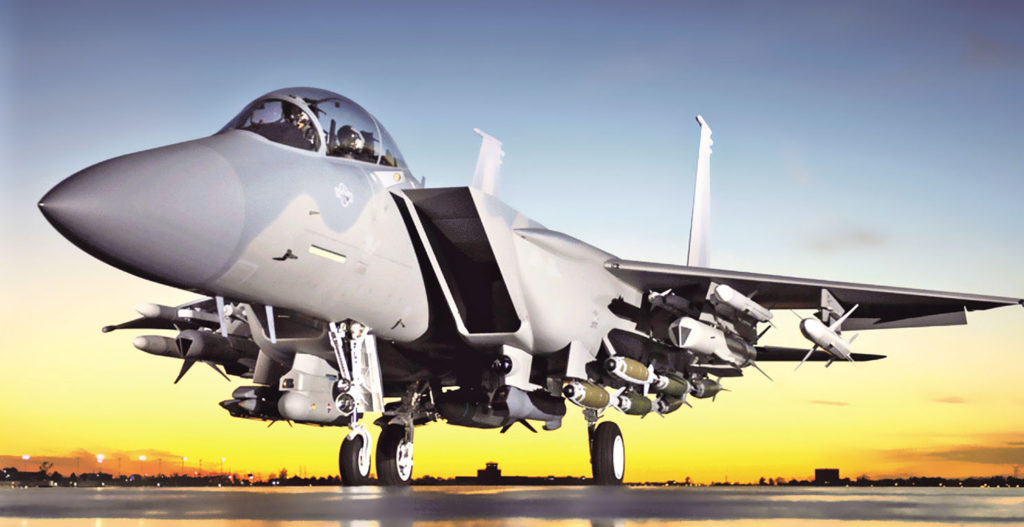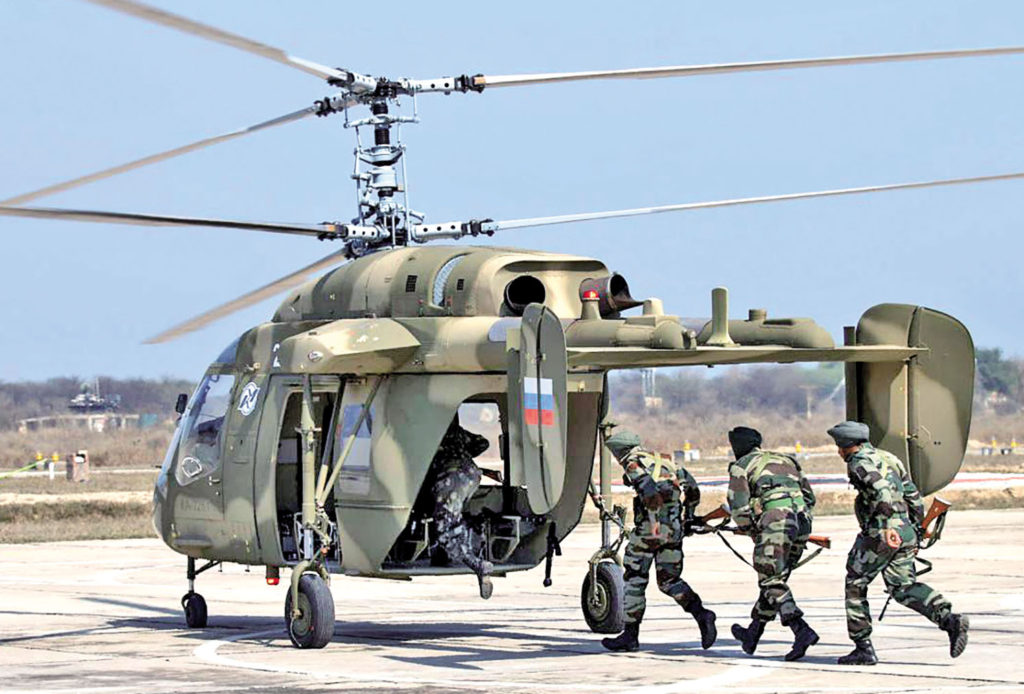Saudi Arabia Evaluating Kalyani Group Artillery Guns
The Pune-based Kalyani Group, which has made a major foray into the field of artillery gun systems, is pitching strongly to supply artillery gun systems to the Saudi Arabian military.
Two types of gun systems, both designed and developed by Kalyani Group, will be sent later in 2020 to Saudi Arabia, for trial evaluation by the Royal Saudi Army in the harsh Saudi Arabian desert. The guns include the so-called Bharat 52, a 155mm/52 calibre towed howitzer that is the first gun the Kalyani Group built. Saudi Arabia will also evaluate the Garuda V2, a 105 mm gun mounted on a light vehicle chassis for added mobility.
Kalyani Group, by virtue of its organic skills in metal castings and forgings, is playing the larger role, including building barrels for its own, as well as Tat Advanced Systems’ gun.
Initial Operational Clearance for HAL Light Utility Helicopter
The Hindustan Aeronautics Limited (HAL) has received the initial operational clearance (IOC) for its light utility helicopter (LUH), paving the way for its production.
There is requirement of some 484 light copters for the three armed forces and the LUH is expected to fill in with at least 187. However, there is no order for manufacturing so far from either the Indian Air Force or the Indian Army.
The LUH is a single engine, lightweight, highly agile 3-tonne utility helicopter, indigenously designed and developed to meet the operational requirements of Indian Army and the IAF.
The nimble 3-tonne LUH began development in 2009 and first flew in 2016. In just four years, the machine has proved itself admirably in trials in super-high altitude regions like Leh and the hot deserts.
The LUH will replace the Army and Air Force’s fleet of over 200 vintage French-designed Cheetah and Chetak helicopters that have been in service for over 50 years. Navy Chetaks will be replaced by the Naval Utility Helicopter project being steered under the Strategic Partnership project.
The IAF and the Army need 384 light utility helicopters – at least 184 of these will be built by HAL and the remaining 200 machines by the Ka-226 being built by an Indo-Russian joint venture. These procurements will of course be dictated by available budgets.
Show-cause Notice to Reliance Naval
In fresh punitive action against the Anil Ambani-promoted Reliance Naval and Engineering Limited (R-Naval) the government has issued a show-cause notice to the debt-ridden company and encashed all its different bank guarantees worth around Rs 980 crore, for its failure to deliver five naval offshore patrol vessels (NPOVs) under a Rs 2,500 crore deal,
R-Naval will have to explain within a month why the contract inked in May 2011, under which the five 2,000-tonne NPOVs were to be delivered from 2014-2015 onwards, should not be cancelled forthwith.
R-Naval had earlier been taken to the National Company Law Tribunal (NCLT) by the IDBI Bank for debt-resolution, with the latter also recently filing an application to initiate insolvency proceedings against the company.
R-Naval had inherited the contract for the NOPVs, the largest such warship deal awarded to the private sector, after it acquired Pipavav Defence and Offshore Engineering Company Ltd, which had gone under heavy debt, in 2015.
The work at the Pipavav shipyard in Gujarat had earlier come to a grinding halt but there was some progress after R-Naval took over the reins, with the first two NOPVs, Shachi and Shruti, being “launched” in July 2017.
R-Naval had also announced grandiose plans of constructing even bigger warships and submarines for the Indian Navy as well as servicing and repairing warships of the US Navy’s Seventh Fleet stationed in Japan. But no such plans actually materialized on the ground.
In December 2018, the then Navy chief Admiral Sunil Lanba had dismissed any talk of “preferential treatment” being given to R-Naval, stressing that some of its bank guarantees were being encashed as a penalty against failure to deliver the OPVs in time.
Boeing Looks to Accelerate Manufacturing
US giant Boeing said, on 6 February, that it was looking to accelerate manufacturing engineering and services, develop a globally competitive aerospace workforce besides investing in innovation, digitisation, research and technology.
Boeing highlighted future investments to accelerate its “Make in India” efforts and the capabilities being proposed for the Indian armed forces, specifically the next generation F/A-18 Block III Super Hornet fighter.
The F/A-18, on offer to the Indian Navy, is fully compatible with the carriers and will boost the growing maritime and defence relationship between the US and Indian navy.
Boeing also affirmed its commitment to provide its defence customers with data-based information for empowered decision support and optimisation of operations and missions.
The Boeing India Engineering and Technology Center in Bengaluru and Chennai undertakes advanced aerospace work and supports Boeing’s global engineering growth. Boeing has made strategic investments in an upcoming wholly owned engineering and technology campus with future avionics manufacturing and assembly capability in Bengaluru.
Boeing Mulls F-15EX offer to India
Boeing is contemplating pitching the F-15EX to New Delhi for one of the country’s long-running fighter procurements – a contest in which its F/A-18E/F is already competing.
The company has requested US government clearance to offer the twin-engined type for an Indian air force requirement for 110 fighters, while it continues to offer the F/A-18 Super Hornet to both the Indian navy and Indian air force, and our F-15 is experiencing a resurgence in interest in the US and around the world.


The licence will allow Boeing to discuss the F-15EX with Indian officials in compliance with the USA’s International Traffic in Arms Regulations.
Boeing’s move would see it offer the latest EX variant of the long-running F-15 to New Delhi. Enhancements over previous iterations include a active electronically scanned array radar and improved payload.
The potential entry of the F-15 into the contest is the latest twist in yet another convoluted Indian procurement exercise. After the collapse of its Medium Multi-Role Combat Aircraft (MMRCA) fighter acquisition in 2015, New Delhi rebooted the requirement, initially as an acquisition of a single-engined type, which was later broadened to include twin-engined aircraft.
Likely contenders for the new, poorly-defined requirement already represent a virtual who’s who of combat aircraft. They include the single-engined Lockheed Martin F-16V – dubbed the F-21 for the Indian contest – and Saab Gripen E/F, alongside the twin-engined Dassault Rafale, Eurofighter Typhoon, and Super Hornet. Russia is also likely to offer the RAC MiG-35 and Sukhoi Su-35.
In addition, there is a separate 57-aircraft requirement for the Indian Navy, which Boeing is also addressing with the F/A-18E/F.
For the air force offer, competitors have made much of their willingness to offer New Delhi generous industrial participation, in line with the “Make in India” programme.
IRHL Aims to Achieve 70% Localisation of Kamov Copters
India aims to achieve the target of 70 per cent local content by the time the last of the Russian-origin Kamov 226T helicopter is delivered, The Russian Helicopters Holding Company (part of Rostec State Corporation) signed a roadmap with the IRHL, on 6 February, for localisation of Ka-226T helicopter production in India.
The first batch of helicopters will come out of our production facility at Tumkur in Karnataka by 2025 if everything goes as per plan. The Defence Acquisition Council of the Ministry of Defence was expected to give a go-ahead to the signing of a formal contract.
The roadmap reflects timelines for setting up production facility in India, contracting with suppliers, transferring design documentation, supplying technological equipment and machine kits, training Indian personnel and other key stages of the project to localise production of Ka-226T.


The copter had two sources of parts – Russian origin and western origin. Around 74 per cent of the copter is of Russian parentage. Its engine is from Safran France.
For the 140 copters to be made in India, the Russian part of the content will be indigenised in phases. We will have 70 per cent local content in place of Russian components by the end of phase IV of production. This will include the technology for rotors.
Indo-Russian Helicopters Limited is a joint venture of Russian Helicopters, Rosoboronexport and the HAL. The company was registered in India in May 2017 as part of a project to localise production of Ka-226T helicopters.
HAL Needs New Orders to Keep Going After 2021-22
Hindustan Aeronautics Limited (HAL) is betting on the Indian Air Force (IAF) to place the Rs 39,000 crore order for 83 Tejas LCA Mk 1A. As part of its existing orders, HAL has to supply 24 LCA jets and a few Sukhoi-30s to the IAF.
HAL’s order books are empty beyond 2021-22 and new orders from the armed forces are critical for continuity in production, the government has told Parliament’s standing committee on defence.
Another order that HAL is eyeing is the supply of 70 locally produced basic trainers to the IAF. If it gets the order for the Hindustan Turbo Trainer-40 (HTT-40), HAL could begin production of the trainers by early 2021.
HAL’s production over last several years has been growing with highest turnover of Rs 19,705 crore recorded in the financial year 2018-19. However, the major part of existing orders for supply of aircraft and helicopters will be liquidated shortly with the major manufacturing order of Su-30MKI being completed in 2019-20.
Considering production/procurement lead time of 18 to 24 months involved in the manufacture of aircraft/helicopters, the existing facilities at HAL face the threat of idling and production will show a declining trend for want of confirmed orders.
Out of the 40 LCAs already ordered by the IAF, 16 have been deliveredin the initial operational clearance (IOC) configuration.













